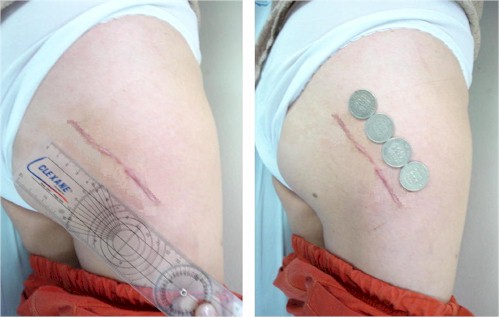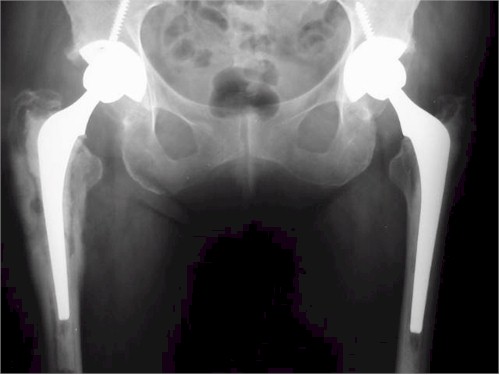|
Nueva Tecnica en abordajes de la cadera. Abordaje Lateral Indirecto Modificado. ALIM.4

Figura 6.

Figura 7.
Además, se han reportado menores estancias medias de hospitalización 2 - 3 días y menores índices de complicaciones de TVP y TEP de 0.86% con profilaxis comparados con la literatura existente cuyos rangos oscilan de 1-3% (24). La tasa de infección hallada es 0.17% la cual se encuentra dentro de los rangos publicados que son aproximadamente dentro 0.1 al 0.2%. No se presentaron casos de osificaciones heterotópicas comparados con los trabajos publicados según Cochrane de 20-23% con otros abordajes. Las luxaciones en un 1.48% encontrándose con mayor frecuencia en los pacientes intervenidos durante los primeros 10 años de este estudio en el rango inferior publicado por la literatura en otros abordajes del 1-5% (24).
Se considera actualmente que el abordaje posterior es mundialmente el más utilizado, sin embargo, se han informado mayores tasas de luxación y lesión del nervio ciático comparado con las vías anteriores y los abordajes laterales directos que a su vez demuestra estos últimos facilidades en el posicionamiento de la copa reduciéndose las tasas de luxación de la cadera. Sin embargo, hay un mayor riesgo de cojera por el compromiso del glúteo medio y lesión del nervio crural (3,9,16,24). En el abordaje lateral indirecto modificado (ALIM) no se presentó casos de lesión del nervio crural o del ciático. El trocánter mayor es respetado mostrando una mayor estabilidad rotacional que es necesaria para el “press fit” de los implantes femorales y de esta manera se cuantifica CR de la cabeza femoral que siempre este situado a nivel de su vértice. Está es una opción más de abordaje, reproducible, que permite una excelente visualización del implante cotiloideo y femoral, permitiendo de esta manera la reconstrucción anatómica individualizada del centro de rotación de la cadera en la pelvis, es decir; con la misma altura, lateralidad y orientación del lado sano. Se recomienda un entrenamiento previo, además, es necesario efectuar estudios randomizados, aleatorizados para validar la eficacia de esté abordaje para la cadera. Bibliografía - Sánchez Mesa Pedro A; Arbeláez A. William R; 2006. Abordaje lateral indirecto modificado en artroplastia de cadera; Revista colombiana de ortopedia y traumatología, septiembre, 20(3), 24-34.
- Sánchez M. Pedro A. Manual Práctico para Residentes de Ortopedia; Ed Carbel, Octubre 2004; 482-500.
- Asayama, m. Naito, m. Fujisawa, and t. Kambe; 2004. Optimum abductor moment arm for total hip arthroplasty, J Bone Joint Surg Br Orthopaedic proceedings, 86-B: 393.
- Jolles BM , Bogoch ER 2004. Posterior versus lateral surgical approach for total hip arthroplasty in adults with osteoarthritis (Cochrane Review) from the Cochrane library, Issue 4, Chichester, UK: John Wiley & Sons.
- Adrian John Bauze, John Charity, Eleftherios Tsiridis, et al; 2007. The Dislocating Hip Arthroplasty: Prevention and Treatment; Journal of Arthrosplasty; Jun; 22 (4): 86-90.
- Christopher M. Farrell, Bryan D. Springer, George J. Haidukewych, et al; 2005. Motor Nerve Palsy Following Primary Total Hip Arthroplasty; J. Bone Joint Surg. Am., Dec; 87: 2619-25.
- Vipul P. Patel, Michael Walsh, Bantoo Sehgal, et al; 2007. Factors Associated with Prolonged Wound Drainage After Primary Total Hip and Knee Arthroplasty; J. Bone Joint Surg. Am., Jan; 89: 33-8.
- George J. Haidukewych, David J. Jacofsky, Arlen D. Hanssen, et al; 2006. Intraoperative Fractures of the Acetabulum During Primary Total Hip Arthroplasty; J. Bone Joint Surg. Am., Sep; 88: 1952-56.
- Markus Flören, D. Kevin Leste; 2006. Lateral Trochanteric Pain Following Primary Total Hip Arthroplasty
Journal of Arthrosplasty; Feb; 21 (2); 233-36. - Sonny Bal, Doug Haltom, Thomas Aleto, et al; 2005. Early Complications of Primary Total Hip Replacement Performed with a Two-Incision Minimally Invasive Technique; J. Bone Joint Surg. Am., Nov; 87: 2432-38.
- E. Louis Peak, Javad Parvizi, Michael Ciminiello, et al; 2005. The Role of Patient Restrictions in Reducing the Prevalence of Early Dislocation Following Total Hip Arthroplasty. A Randomized, Prospective Study; J. Bone Joint Surg. Am., Feb; 87: 247-53.
- Kevin J. Bozic, Michael D. Ries; 2005. The Impact of Infection After Total Hip Arthroplasty on Hospital and Surgeon Resource Utilization; J. Bone Joint Surg. Am., Aug; 87:1746-51.
- P. Kenny, C. P. O’Brien, K. Synnott, et al; 2007. Damage to the Superior Gluteal Nerve During the Direct Lateral Approach to the Hip: A Cadaveric Study; Journal of Arthrosplasty; Dec; 22 (8):1198-1200.
- Tahir Khan, David Knowles; 2005. Trochanteric Heterotopic Ossification After Total Hip Arthroplasty Performed Using a Direct Lateral Approach; Journal of Arthrosplasty; Jun; 20 (4): 467-72.
- Rodrigo Mardones, Carlos Gonzalez, Miguel E. Cabanela, et al; 2005. Trochanteric Heterotopic Ossification After Total Hip Arthroplasty Performed Using a Direct Lateral Approach; Journal of Arthrosplasty; Jun; 20 (4): 467-72.
- R. J. Kampa, A. Prasthofer, D. J. Lawrence-Watt, et al; 2007. The internervous safe zone for incision of the capsule of the hip: a cadaver study J Bone Joint Surg Br, Jul; 89-B: 971-76.
- E. Mayr, M. Krismer, M. Ertl, O. Kessler, et al; 2006. Uncompromised quality of the cement mantle in Exeter femoral components implanted through a minimally-invasive direct anterior approach: a prospective, randomised cadaver study; J Bone Joint Surg Br, Sep; 88-B: 1252-56.
- M. Ikeuchi, T. Kawakami, K. Kitaoka, et al; 2005. Total hip arthroplasty with a sliding iliac graft for acetabular dysplasia; J Bone Joint Surg Br, May; 87-B: 635-39.
- Y.-H. Kim; 2008. The results of a proximally-coated cementless femoral component in total hip replacement: a five- to 12-year follow-up; J Bone Joint Surg Br, Mar; 90-B: 299-305.
- Steven F. Harwin; 2008. Posterior Longitudinal Split Osteotomy for Femoral Component Extraction in Revision Total Hip Arthroplasty; Journal of Arthrosplasty; Jan; 23 (1): 86 -9.
- Hiroyuki Makita, Yutaka Inaba, Kazuo Hirakawa, et al; 2006. Durability of Implant Fixation After Less-Invasive Total Hip Arthroplasty; Journal of Arthrosplasty; Sept; 21(6): 783-90.
- Joaquin Sanchez-Sotelo, George J. Haidukewych, Carol J. Boberg; 2006. Hospital Cost of Dislocation After Primary Total Hip Arthroplasty; J. Bone Joint Surg. Am., Feb; 88: 290-4.
- Kevin J. Bozic, Saam Morshed, Marc D. Silverstein, et al; 2006. Use of Cost-Effectiveness Analysis to Evaluate New Technologies in Orthopaedics. The Case of Alternative Bearing Surfaces in Total Hip Arthroplasty; J. Bone Joint Surg. Am., Apr; 88: 706-14.
- Z. X. Ling and V. P. Kumar; 2006. The course of the inferior gluteal nerve in the posterior approach to the hip; J Bone Joint Surg Br, Dec; 88-B:1580–83.
- Daniel J. Berry, Marius von Knoch, Cathy D. Schleck, et al; 2005. Effect of Femoral Head Diameter and Operative Approach on Risk of Dislocation After Primary Total Hip Arthroplasty; J. Bone Joint Surg. Am., Nov; 87: 2456-63.
- R. A. Haene, M. Bradley, and R. N. Villar; 2007. Hip dysplasia and the torn acetabular labrum: an inexact relationship; J Bone Joint Surg Br, Oct; 89-B: 1289 -92.
- Preetesh D. Patel, Aaron Potts, Mark I. Froimson; 2006. Clinical and Radiographic Assessment of a Modular Cementless Ingrowth Femoral Stem System for Revision Hip Arthroplasty; Journal of Arthrosplasty Feb; 21(2): 172-78.
- Antti Eskelinen, Ilkka Helenius, Ville Remes, et al; 2006. Cementless Total Hip Arthroplasty in Patients with High Congenital Hip Dislocation; J. Bone Joint Surg. Am., Jan; 88: 80-91.
- Aslam Chougle, M.V. Hemmady, J.P. Hodgkinson; 2006. Long-Term Survival of the Acetabular Component After Total Hip Arthroplasty with Cement in Patients with Developmental Dysplasia of the Hip; J. Bone Joint Surg. Am., Jan; 88: 71-9.
- S. Glyn-Jones, H. S. Gill, D. J. Beard, et al; 2005. Influence of stem geometry on the stability of polished tapered cemented femoral stems; J Bone Joint Surg Br, Jul; 87-B: 921-27.
|